|
Bourne
Eau House
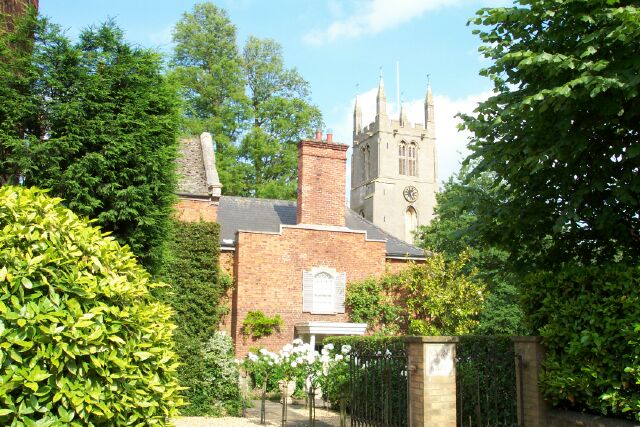
The most charming
private residence in the town must be Bourne Eau House, standing beside the river
on the site of the old Abbey infirmary and overlooking Church Walk, a picture of peace and serenity from another age. The front of the house is in South Street but it is the rear prospect that attracts and visitors can often be seen capturing the view with their cameras and it must surely be one of the most frequently photographed properties in the district,
also being Grade II listed.
It is a complex building, or a series of joined
structures in contrasting styles from different periods between the 16th and
20th centuries. The property began as a single storey timber-framed house built
circa 1580 during the reign of Queen Elizabeth I and in 1630 it was enlarged and
a second storey added with the original cross wall serving as a convenient
support for the massive flooring beam spanning the dining room which remains
intact today, the wood used being reclaimed from salvaged ships' timbers. In
1680 and later, during the reigns of James II and William III, further
accommodation was added and these rooms are used today as a playroom and master
bedroom suite and a recessed wall cupboard in one of the bedrooms is fitted with
the original butterfly hinges dating back to 1660 while a carved oak fire
surround identical to that in the Jacobean music room can be found in Monkstone
House, West Street, one of the oldest buildings in Bourne.
In 1784, the house was again extended to
include the present hallway, drawing room and an additional bedroom above and
this extension was heightened circa 1800 to form the present hallway and
staircase with a Decimus Gothic fanlight on the landing and unusual dual chimney
stacks. The house was again extended at this time to add what is now the
library/study and a bedroom above. A few years later, in 1832, the unusual rear
porch was added, comprising a shaped copper-hooded roof and treillage or lattice
work.
There is a large
stable and store block at the north end of the house built in 1784 and later
contained old beer brewing vats, with grain lofts over. A large listed warehouse
is joined to the house and this was once used for corn and seed distribution by
the Wherry family and although now in separate ownership, both house and
warehouse have been closely connected in past years and a careful look will
reveal the architectural styles that link their relationship.
John Mawby (1758-1818) was a wool merchant who
lived at the house in the early 19th century, followed by his children and
grandchildren, until 1894. The family were all regular worshippers at the Abbey
Church nearby, building the elegant Regency bridge over the Bourne Eau, one of
the few in England ever to be cast from a solid block of iron and connecting the
grounds of the house with the church, to make their journeys shorter on Sundays.
The bridge bears a shield giving the date of construction as 1832 and the family
initial "M".
In 1894, the house was
bought by William Wherry, a county alderman and grain merchant, who remained
there with his family until he died in 1915. During this period, the stables
housed the horses he used to bring grain and produce from barges arriving at the
wharves in Eastgate to his dried pea factory nearby in what is now Church Walk.
After his death, three of his sisters, all widows, lived there for a time but
after they died, the property was left to Daisy, a maid, much to the chagrin of
the family, but she was unable to maintain the property which soon fell into
disrepair.
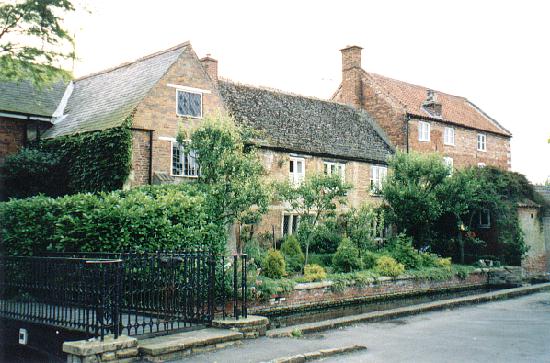 |
|
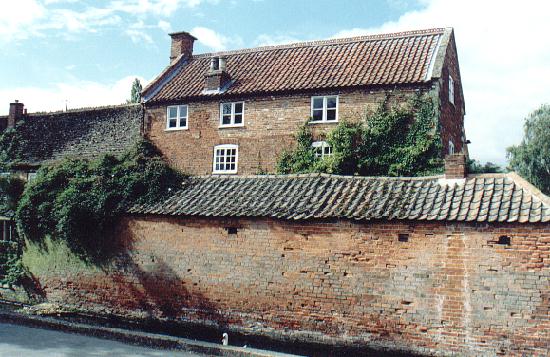 |
|
The warehouse and outbuildings at Bourne Eau House
were once the home and headquarters of Alderman
William Wherry while the bridge (below) was built by the Mawby
family who were earlier tenants. |
|
 |
During this period, the house was called The Cedars because
of a large and stately cedar tree growing in the garden but it was blown down
in a gale on 3rd January 1976. Daisy eventually sold the house to a Mr
Smith, a sergeant serving with the United States Air Force who made rocking
horses but he sold it three years
later when the name was changed to
Bourne Eau House. The new owner was another American, Mr J
Douglas White, of Lincoln County, Mississippi, and latterly from California, who
had worked as secretary to the American multi-millionaire film maker and
recluse, Howard Hughes. He
was then employed as an electronics designer with the Space Technology Laboratories in London and
moved to Bourne to retire with his brother-in-law, Mr James Burrill, completing
the purchase of the house in 1977. Both were also writers and featured their new
home and a history of the town in an article for the local newspaper
circulating in Lincoln County, USA. Two mature swamp cypress trees standing
either side of the path from the river to the back door of the house were
planted by Douglas and James as a reminder of their homeland.
The house had been neglected in previous years and extensive
modernisation work was carried out before they moved in during 1979 but the new
owners retained its period charm and the result is a pleasing mix without
ostentation and retaining the red brick Georgian appearance that enhances so
many of the historic buildings in the town.
The property is now in the form of a cross with
the original hall in the centre. The accommodation is extensive and may even be
described as rambling as every step and turn reveals another surprise and more
interest for the curious. The American ownership ended in the 1990s when the
house was again sold by Douglas and James to Dr Bishop and his wife and they
turned it into an upmarket bed and breakfast establishment while Dr Bishop also
wrote a number of books during the time he lived there. When he moved to South
Wales in 1999, the property was sold to Martin Preen and his family and when
they decided to move to Stamford in 2008, the house was offered for sale for an
asking price of just under £1 million although this was later reduced to offers
in excess of £875,000.
The house itself is not reputed to be haunted
although there is a local legend that a woman has been seen walking from the nearby
churchyard into the garden.
|
A WALK ROUND DESCRIPTION
Reproduced from The Local newspaper Friday 9th May
2008
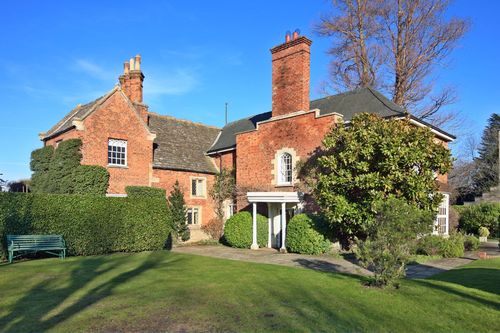
WALKING around Bourne Eau House is like taking a
step back in time. While the decor is simple and stylish to suit modern
tastes, the property is jam packed with original historical and
architectural features dating back well over 400 years.
The Grade II listed house, sitting next to Bourne Eau river in the
shadow of the 12th century Augustinian Bourne Abbey, has been the home
of the Preen family for nine years. But the stunning seven bedroom
property is on the market because owners Martin, aged 43, his wife
Caroline, 40, and their three children, Harry, 11, Eloise, 9, and
Charlie, 8, are moving to a Georgian property in Stamford.
Martin says: "This has been very much a family home and we have
thoroughly enjoyed living here. We love period properties and there is
no denying this house is full of character. The new owners will not only
be purchasing an extensive and much-loved home but a slice of local
history."
When the family bought Bourne Eau House it was being run by an elderly
couple as an upmarket bed and breakfast. Martin said: "The interior was
a little tired, stuck in a 1970s time warp, but the majority of work we
had to undertake was cosmetic improvements such as plastering, painting
and new flooring."
Everywhere you look there is something to fascinate or surprise. The
house is understood to have been built on the 12th century foundations
of an Augustinian Abbey hospice, then converted into almshouses, and
dates back to the 1500s, with 17th, 18th and 19th century additions. On
the ground floor there is a drawing room, music room, kitchen, breakfast
room, library/study, playroom and cloakroom. Upstairs there is a master
bedroom suite with en suite bathroom and dressing room, two en suite
bedrooms, four further bedrooms, two bathrooms and a large open plan
office/study. Rooms at the back of the house enjoy fabulous views of
Bourne Abbey and those at the front overlook the Memorial Gardens in
South Street.
The dining room is in the oldest part of the house, having been built in
the 1500s, and it is stuffed with original features. There is an
inglenook fireplace, two warming ovens with cast iron doors, a beamed
ceiling, cheese cupboard, York flagstone floor, leaded mullion windows
and hand carved wooden sconces. The central hallway was added in the
17th century and has an original York flagstone floor. The master
bedroom suite is also 17th century, having been added in the 1680s, and
it boasts an exposed original brick wall, scroll and foliate cornice
frieze on the side walls and an oak fire surround with carved motifs,
originally part of an altar from Bourne Abbey.
One of the other bedrooms has a Carolingian stone fireplace from the
1640s and exposed oak beams with yet another having a cast iron Georgian
fireplace and tiled hearth, ceiling cornice and picture rail. The music
room is within the Jacobean part of the house and boasts a magnificent
carved oak fire surround with heraldic central panel and lunette
carving. It was carved by Jack Rayner, of Bourne, out of wood salvaged
from 16th century cottages that burned down in 1605. The room also has a
restored hardwood herringbone parquet floor and an original oak beamed
ceiling.
The main entrance hall and drawing room were added in the 1700s. Both
rooms feature original Georgian architecture and artefacts, including an
impressive marble effect chequered tiled floor, framed wall mirrors,
acanthus leaf patterned coving and banister in the hallway and marble
fire surround, restored pine floorboards and plaster leaf design coving
in the drawing room.
The library/study, added in about 1800, boasts an original oak Gothic
style fireplace with an inset cast iron fireplace featuring hand painted
Dutch tiles.
The property stands in about three quarters of an acre of formal gardens
with a rare Grade 11 listed wrought iron Regency bridge spanning the
Bourne Eau, which borders the east side of the house. There is even an
original brewhouse and three-bay stable block.
Just when you think you have exhausted all the delights this historic
property has to offer, Bourne Eau House has another surprise up its
sleeve.
Martin said: "Jack the swan has lived here for as long as we have and we
like to think of him as the guardian of the house. He has a damaged
wing, which means he cannot fly and he is alone after his partner died a
few years ago. Jack sleeps under a tree in the garden next to the river
and we feed him during the winter. We hope that the next owner of the
house will do the same."


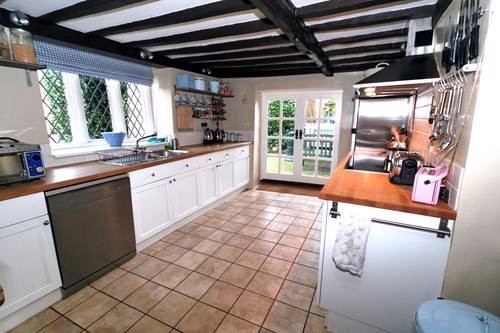
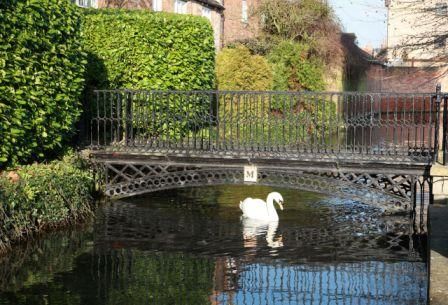
See also
Jack Rayner |
|
BOURNE EAU HOUSE
IN PAST TIMES This picture was taken in 1950 by
painter and decorator Graham Luesby. He was working on the roof of
Wherry's warehouse in South Street, now demolished, and found himself
looking down on to the front facade of the building, a photo opportunity
too good to be missed. There have been drastic alterations to the
appearance of the property since, the front courtyard being replaced by
landscaped gardens, but its exclusive location only a few yards from the
church is clearly defined. |
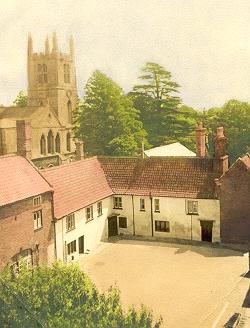 |
|
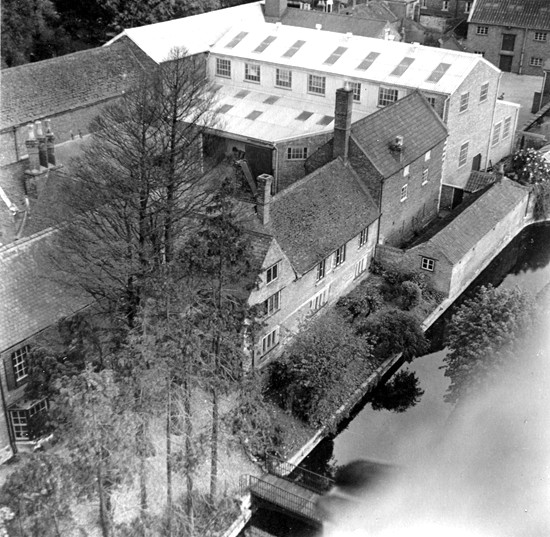 |
|
A view from the church tower taken by Trevor Brodrick, circa 1950,
showing the old pea factory on the right and other outbuildings, now all
demolished. |
See also The
Mawby family William
Wherry

Go
to: Main Index
|










